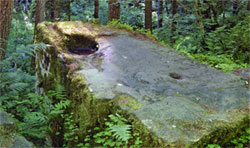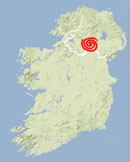18 Aug St. Patrick’s Chair and Well
“We enjoin, that every priest zealously promote Christianity, and totally extinguish every heathenism; and forbid well worshippings, and necromancies, and divinations, and enchantments, and man worshipping and the vain practices which are carried on with various spells…and with stones, and with many various delusions, with which men do much of what they should not…And we enjoin, that on feast days heathen songs and devil’s games be abstained from.”
The Ecclesiastical Canons of King Edgar, 959 CE1
Drag within the image to explore St. Patrick’s Chair and Well in virtual reality.
Altadaven Glen, the light-dappled dreamscape location of St. Patrick’s Chair and Well, seems like a small patch of fern-filled rain forest magically dropped into Co. Tyrone. It lies along the Ulster Way footpath in the Favour Royal Demesne, now part of the People’s Millennium Forest. The original name of Favour Royal reflects the granting of this piece of Ulster to Sir Thomas Ridgeway in 1611 as a favor of King James I.2
As you walk up the steep rise into this remarkable setting, it is obvious why Altadaven Glen can be described as a “powerful place.”3 Clearly the faithful who leave their supplications in the branches of its two “rag trees” sense the power. In this wet environment, water naturally collects in the “well,” which is actually a 25-cm (10-in) sculpted bullaun in a large horizontal rock platform. According to the folklore of the site, the little basin never runs dry. Its water is said to cure many maladies, but is known especially for the treatment of warts.4 For a further discussion of bullaun stones, see our page on the Kilmalkedar Keelers Stone in Co. Kerry.
Above the well is Spink-ana-gaev, or “Pinnacle Rock.” At some time lost to history a gigantic throne 2 m (6.5 ft) high, now called St. Patrick’s Chair, was carved into one of the massive boulders. Some of the stones nearby have megalithic cup-marks.5 In the virtual-reality environment (above) you will begin at St. Patrick’s Chair. You can then click the hotspot to descend the stairs down to the well and the rag trees below.
In his account of a visit to the site in 1898, a Catholic priest reported that the rock seat was specifically for the benefit of St. Patrick:
“Fronting the altar on the gospel-side is another huge structure of rock, so formed by nature out of a single massive block as to have the appearance of a gigantic high- backed chair. It measures from the basement to its head not less than eight feet ; the square high back rising some six feet above the seat. In this chair, tradition reports, St. Patrick sat, and at this altar celebrated the Sacred Mysteries; and from time immemorial both altar and chair have been called by his name…” 6
One translation of the name Altadaven is “The Demons’ Cliff,” evidently stemming from the story of St. Patrick driving devils off the cliff to their demise. The site was reportedly involved in Lughnasa celebrations until the modern era.7
Altadaven Glen may have originally been a site dedicated to St. Brigid, and perhaps the pagan goddess Brighid before her.
The area had a reputation during the early Christian years as a center for Druidic rites.8 The early Irish manuscripts, all from after the beginning of the Christian era, may sometimes describe a flavor of Christian observance that might be labeled “Druidical.” “As the performances of Saints are precisely similar to those attributed to Druids, one is naturally puzzled to know where one party quits the field and the other comes on.”9
However as the quotation at the top of the page attests, after the initial era of benign co-existence official Christendom grew less tolerant of continued observance of pagan practices. As Father Livius goes on in his report:
“Now, it is generally thought, and on very probable grounds, that Altadavin was specially set apart by the Druids for the exercise of their religious worship. The wild rocky glen is just the sort of place they would naturally select…
Here they could in secret solitude perform their weird and mystic rites at the overshadowed well, and immolate their victims at the altar on the high place. The legendary folk-lore which still lingers among the people from ancient time…point to it as a spot of awe and marvel…
St. Patrick, during his residence at Clogher, and his evangelization of that city and its neighbourhood, would certainly have directed all his efforts to extirpating the prevalent pagan and druidical rites, and to diverting their profane objects to Christian uses.” 10
As one might expect from a site so richly endowed with both atmosphere and legend, Altadaven Glen was also known as a setting for romance. In a tale called Shane Fadh’s Wedding, author William Carleton in 1881 made use of the location for a nascent love affair amidst the moist greenery and the ancient stones hewn by an earlier race:
“The next Sunday we met at Althadhawan wood, and I’ll never forget what I felt when I was going to the green at St. Patrick’s Chair, where the boys and girls meet on Sunday; but there she was—the bright eyes dancing: with joy in her head to see me. We spent the evening in the wood, till it was dusk…” 11
Click here to see all the notes from this page.
St. Patrick’s Chair and Well, Co. Tyrone
Nearest Town: Clogher
Townland: Altadaven
Latitude: 54° 23′ 29.14″ N
Longitude: 7° 4′ 51.08″ W
External Links:


